cover
Cover
title:
author:
publisher:
isbn10 | asin:
print isbn13:
ebook isbn13:
language:
subject
publication date:
lcc:
ddc:
subject:
Plasma Physics and Engineering
Fridman, Alexander A.; Kennedy, Lawrence A.
Taylor & Francis Routledge
1560328487
9781560328483
9780203334874
English
Plasma (Ionized gases) , Plasma engineering, Plasma (Gaz
ionisés) , Plasmas, Technique des.
2004
QC718.F77 2004eb
530.4/4
Plasma (Ionized gases) , Plasma engineering, Plasma (Gaz
ionisés) , Plasmas, Technique des.
cover
Page i
Plasma Physics and Engineering
Page ii
This page intentionally left blank.
Page iii
Plasma Physics and Engineering
Alexander Fridman
Lawrence A.Kennedy
NEW YORK • LONDON
Page iv
Denise T.Schanck, Vice President
Robert L.Rogers, Senior Editor
Summers Scholl, Editorial Assistant
Savita Poornam, Marketing Manager
Randy Harinandan, Marketing Assistant
Susan Fox, Project Editor
page_i
page_ii
page_iii
file:///G|/SMILEY/1560328487__gigle.ws/1560328487/files/__joined.html[03/10/2009 12:35:58]
�
cover
Shayna Murry, Cover Designer
Published in 2004 by
Taylor & Francis
29 West 35th Street
New York, NY 10001-2299
This edition published in the Taylor & Francis e-Library, 2006.
To purchase your own copy of this or any of Taylor & Francis or Routledge’s collection of thousands of eBooks
please go to www.eBookstore.tandf.co.uk.
Published in Great Britain by
Taylor & Francis
4 Park Square
Milton Park
Abingdon OX14 4RN
www.taylorandfrancis.com
Copyright © 2004 by Taylor & Francis Books, Inc.
All rights reserved. No part of this book may be reprinted or reproduced or utilized in any
form or by any electronic, mechanical, or other means, now known or hereafter invented,
including photocopying and recording, or in any information storage or retrieval system,
without permission in writing from the publishers.
10 9 8 7 6 5 4 3 2 1
Library of Congress Cataloging-in-Publication Data
Fridman, Alexander A., 1953–
Plasma physics and engineering/by Alexander
A.Fridman and Lawrence A.Kennedy
p. cm.
ISBN 1-56032-848-7 (hardcover: alk. paper)
1. Plasma (Ionized gases). 2. Plasma engineering. I. Kennedy, Lawrence A., 1937–
II. Title.
QC718.F77 2004
530.4′4–dc22 2003022820
ISBN 0-203-33487-6 Master e-book ISBN
ISBN 1-56032-848-7 (Print Edition)
page_iv
Page v
Preface
Plasma enjoys an important role in a wide variety of industrial processes, including material processing;
environmental control; electronic chip manufacturing; light sources; bio-medicine; and space propulsion. It is
also central to understanding most of the universe outside the Earth. As such, the focus of this book is to
provide a thorough introduction to the subject and to be a valued reference that serves engineers and
scientists as well as students. Plasma is not an elementary subject and the reader is expected to have the
normal engineering background in thermodynamics, chemistry, physics, and fluid mechanics upon which to
build an understanding of this subject.
This text has been organized into two parts. Part I addresses the basic physics of plasma. Chapter 2 examines
the elementary processes of charge species in plasma and Chapter 3 provides a thorough introduction to the
elementary processes of excited molecules and atoms in plasmas. Chapter 4 and Chapter 5 examine the
kinetics of charged/excited particles and Chapter 6 gives a thorough introduction to the electrostatics,
electrodynamics, and fluid mechanics of plasma.
Part II addresses the physics and engineering of electric discharges, specifically examining glow and arc
discharges (Chapter 7 and Chapter 8); cold atmospheric pressure discharges typically associated with corona,
dielectric barrier, and spark discharges (Chapter 9); plasma created in high-frequency electromagnetic fields
characterized by radio-frequency, microwave, and optical discharges (Chapter 10); and discharges in aerosols
and dusty plasmas (Chapter 11). The second part of Chapter 12 concludes with discussions on electron beam
plasmas. The authors have drawn upon extensive work in the Russian literature in addition to the more
accessible results from the West. We believe that this will add an important dimension to development of this
subject.
This text is adaptable to a wide range of needs. The material has been taught to graduate and senior-level
students from most engineering disciplines and physics. For the latter, it can be packaged to focus on the
basic physics of plasma with only selections from discharge applications. For graduate courses, a faster pace
file:///G|/SMILEY/1560328487__gigle.ws/1560328487/files/__joined.html[03/10/2009 12:35:58]
�
cover
can be set that covers Part I and Part II. Presently, the text is used for a plasma engineering course sequence
(Plasma I, Plasma II) at Drexel University.
We gratefully acknowledge the loving support of our wives, Irene Fridman and Valaree Kennedy; the
governmental research support of the National Science Foundation and the U.S. Department of Energy,
together with our long-term industrial sponsors, Air Liquide, Texaco, Kodak, Georgia Pacific, and Applied
Materials. We especially appreciate John and Chris Nyheim and the Kaplan family for their support of plasma
research at Drexel University and University of Illinois at Chicago. Additionally, we gratefully acknowledge the
invaluable, stimulating discussions with our colleagues, Professors Young Cho, Gary Friedman, Baki Farouk,
Alexei V.Saveliev
page_v
Page vi
and Alexander Gutsol, and our students. We thank K.Gutsol, A.Fridman, G. Fridman, and A.Chirokov for help
with illustrations.
Alexander Fridman
Lawrence A.Kennedy
page_vi
Page vii
Table of Contents
PART I Fundamentals of Plasma Physics and Plasma Chemistry
Chapter
1
Plasma in Nature, in the Laboratory, and in Industry
Chapter
2
1.1 Occurrence of Plasma: Natural and Manmade Plasmas
1.2 Gas Discharges
1.3 Plasma Applications: Plasmas in Industry
1.4 Plasma Applications for Environmental Control
1.5 Plasma Applications in Energy Conversion
1.6 Plasma Application for Material Processing
Elementary Processes of Charged Species in Plasma
Page viii
2.1 Elementary Charged Particles in Plasma and Their Elastic and Inelastic Collisions
2.1.1 Electrons
2.1.2 Positive Ions
2.1.3 Negative Ions
2.1.4 Elementary Processes of Charged Particles
2.1.5 Fundamental Parameters of Elementary Processes
2.1.6 Reaction Rate Coefficients
2.1.7 Elementary Elastic Collisions of Charged Particles
2.2 Ionization Processes
2.2.1 Direct Ionization by Electron Impact
2.2.2 Direct Ionization Rate Coefficient
2.2.3 Peculiarities of Dissociation of Molecules by Electron Impact: the Frank-Condon Principle
and the Process of Dissociative Ionization
2.2.4 Stepwise Ionization by Electron Impact
2.2.5 Ionization by High Energy Electron Beams
2.2.6 Photoionization Processes
2.2.7 Ionization by Collisions of Heavy Particles: Adiabatic Principle and Massey Parameter
2.2.8 The Penning Ionization Effect and Process of Associative Ionization
2.3 Mechanisms of Electron Losses: Electron-Ion Recombination
2.3.1 Different Mechanisms of Electron-Ion Recombination
2.3.2 Dissociative Electron-Ion Recombination
page_vii
2.3.3 Ion Conversion Reactions as a Preliminary Stage of Dissociative Electron-Ion
Recombination
1
3
4
6
8
10
11
13
15
15
16
17
18
19
20
21
22
24
24
26
28
29
32
33
34
35
36
37
38
40
file:///G|/SMILEY/1560328487__gigle.ws/1560328487/files/__joined.html[03/10/2009 12:35:58]
�
cover
Chapter
3
2.3.4 Three-Body Electron-Ion Recombination
2.3.5 Radiative Electron-Ion Recombination
2.4 Electron Losses due to Formation of Negative Ions: Electron Attachment and Detachment
Processes
2.4.1 Dissociative Electron Attachment to Molecules
2.4.2 Three-Body Electron Attachment to Molecules
2.4.3 Other Mechanisms of Formation of Negative Ions
2.4.4 Mechanisms of Negative Ion Destruction: Associative Detachment Processes
2.4.5 Electron Impact Detachment
2.4.6 Detachment in Collisions with Excited Particles
2.5 Ion-Ion Recombination Processes
2.5.1 Ion-Ion Recombination in Binary Collisions
2.5.2 Three-Body Ion-Ion Recombination: Thomson’s Theory
2.5.3 High-Pressure Limit of Three-Body Ion-Ion Recombination: Langevin Model
2.6 Ion-Molecular Reactions
2.6.1 Ion-Molecular Polarization Collisions: Langevin Rate Coefficient
2.6.2 The Ion-Atom Charge Transfer Processes
2.6.3 Nonresonant Charge Transfer Processes
2.6.4 Ion-Molecular Reactions with Rearrangement of Chemical Bonds
2.6.5 Ion-Molecular Chain Reactions and Plasma Catalysis
2.6.6 Ion-Molecular Processes of Cluster Growth: the Winchester Mechanism
Problems and Concept Questions
Elementary Processes of Excited Molecules and Atoms in Plasma
3.1 Electronically Excited Atoms and Molecules in Plasma
3.1.1 Electronically Excited Particles: Resonance and Metastable States
3.1.2 Electronically Excited Atoms
3.1.3 Electronic States of Molecules and Their Classification
3.1.4 Electronically Excited Molecules and Metastable Molecules
3.2 Vibrationally and Rotationally Excited Molecules
3.2.1 Potential Energy Curves for Diatomic Molecules: Morse Potential
3.2.2 Vibration of Diatomic Molecules: Model of Harmonic Oscillator
page_viii
Page ix
3.2.3 Vibration of Diatomic Molecules: Model of Anharmonic Oscillator
3.2.4 Vibrationally Excited Polyatomic Molecules: the Case of Discrete Vibrational Levels
3.2.5 Highly Vibrationally Excited Polyatomic Molecules: Vibrational Quasi Continuum
3.2.6 Rotationally Excited Molecules
3.3 Elementary Processes of Vibrational, Rotational, and Electronic Excitation of Molecules in Plasma
3.3.1 Vibrational Excitation of Molecules by Electron Impact
3.3.2 Lifetime of Intermediate Ionic States during Vibrational Excitation
3.3.3 Rate Coefficients of Vibrational Excitation by Electron Impact: Semiempirical Fridman’s
3.3.4 Rotational Excitation of Molecules by Electron Impact
3.3.5 Electronic Excitation of Atoms and Molecules by Electron Impact
3.3.6 Rate Coefficients of Electronic Excitation in Plasma by Electron Impact
3.3.7 Dissociation of Molecules by Direct Electron Impact
3.3.8 Distribution of Electron Energy in Nonthermal Discharges between Different Channels of Excitation
Approximation
and Ionization
3.4 Vibrational (VT) Relaxation; the Landau-Teller Formula
3.4.1 Vibrational-Translational (VT) Relaxation: Slow Adiabatic Elementary Process
3.4.2 Quantitative Relations for Probability of the Elementary Process of Adiabatic VT Relaxation
3.4.3 VT Relaxation Rate Coefficients for Harmonic Oscillators: Landau-Teller Formula
3.4.4 Vibrational VT Relaxation of Anharmonic Oscillators
3.4.5 Fast Nonadiabatic Mechanisms of VT Relaxation
3.4.6 VT Relaxation of Polyatomic Molecules
3.4.7 Effect of Rotation on the Vibrational Relaxation of Molecules
3.5 Vibrational Energy Transfer between Molecules: VV Relaxation Processes
3.5.1 Resonant VV Relaxation
file:///G|/SMILEY/1560328487__gigle.ws/1560328487/files/__joined.html[03/10/2009 12:35:58]
40
42
42
43
46
47
48
50
51
52
52
55
56
58
58
61
64
65
66
67
69
73
73
74
74
77
78
81
81
84
86
88
92
94
96
96
97
100
101
103
104
106
107
113
113
115
117
119
121
122
124
125
125
�
cover
3.5.2 VV Relaxation of Anharmonic Oscillators
3.5.3 Intermolecular VV′ Exchange
3.5.4 VV Exchange of Polyatomic Molecules
3.6 Processes of Rotational and Electronic Relaxation of Excited Molecules
3.6.1 Rotational Relaxation
3.6.2 Relaxation of Electronically Excited Atoms and Molecules
3.6.3 Electronic Excitation Energy Transfer Processes
page_ix
127
130
132
135
135
137
138
Page x
Chapter
4
3.7 Elementary Chemical Reactions of Excited Molecules; Fridman-Macheret α-Model
3.7.1 Rate Coefficient of Reactions of Excited Molecules
3.7.2 Potential Barriers of Elementary Chemical Reactions: Activation Energy
3.7.3 Efficiency α of Vibrational Energy in Overcoming Activation Energy Barrier
3.7.4 Fridman-Macheret α-Model
3.7.5 Efficiency of Vibrational Energy in Elementary Reactions Proceeding through Intermediate
Complexes
3.7.6 Dissociation of Molecules Stimulated by Vibrational Excitation in Nonequilibrium Plasma
3.7.7 Dissociation of Molecules in Nonequilibrium Conditions with Essential Contribution of
Translational Energy
3.7.8 Chemical Reactions of Two Vibrationally Excited Molecules in Plasma
Problems and Concept Questions
Plasma Statistics and Kinetics of Charged Particles
139
139
140
142
142
146
149
151
155
155
161
161
4.1 Statistics and Thermodynamics of Equilibrium and Nonequilibrium Plasmas: Boltzmann,
Saha, and Treanor Distributions
4.1.1 Statistical Distribution of Particles over Different States: Boltzmann Distribution
161
4.1.2 Equilibrium Statistical Distribution of Diatomic Molecules over Vibrational-Rotational States 163
4.1.3 Saha Equation for Ionization Equilibrium in Thermal Plasma
164
4.1.4 Dissociation Equilibrium in Molecular Gases
165
4.1.5 Equilibrium Statistical Relations for Radiation: Planck Formula and Stefan-Boltzmann Law 165
4.1.6 Goncepts of Complete Thermodynamic Equilibrium (CTE) and Local Thermodynamic
167
Equilibrium (LTE) for Plasma Systems
4.1.7 Partition Functions
4.1.8 Thermodynamic Functions of Thermal Plasma Systems
4.1.9 Nonequilibrium Statistics of Thermal and Nonthermal Plasmas
4.1.10 Nonequilibrium Statistics of Vibrationally Excited Molecules: Treanor Distribution
4.2 Boltzmann and Fokker-Planck Kinetic Equations: Electron Energy Distribution Functions
4.2.1 Boltzmann Kinetic Equation
4.2.2 The τ-Approximation of the Boltzmann Kinetic Equation
4.2.3 Macroscopic Equations Related to Kinetic Boltzmann Equation
4.2.4 Fokker-Planck Kinetic Equation for Determination of Electron Energy Distribution
Functions
168
168
170
172
176
176
178
179
180
page_x
Page xi
4.2.5 Different Specific Electron Energy Distribution Functions: Druyvesteyn Distribution
4.2.6 Electron Energy Distribution Functions in Different Nonequilibrium Discharge Conditions
4.2.7 Relations between Electron Temperature and Reduced Electric Field
4.3 Electric and Thermal Conductivity in Plasma: Diffusion of Charged Particles
4.3.1 Isotropic and Anisotropic Parts of Electron Distribution Functions
4.3.2 Electron Mobility and Plasma Conductivity
4.3.3 Similarity Parameters Describing Electron Motion in Nonthermal Discharges
4.3.4 Plasma Conductivity in Perpendicular Static Uniform Electric and Magnetic Fields
4.3.5 Conductivity of Strongly Ionized Plasma
4.3.6 Ion Energy and Ion Drift in Electric Field
4.3.7 Free Diffusion of Electrons and Ions
4.3.8 Einstein Relation among Diffusion Coefficient, Mobility, and Mean Energy
4.3.9 Ambipolar Diffusion
4.3.10 Conditions of Ambipolar Diffusion: Debye Radius
183
186
187
189
189
190
192
193
195
196
197
199
199
201
file:///G|/SMILEY/1560328487__gigle.ws/1560328487/files/__joined.html[03/10/2009 12:35:58]
�
cover
4.3.11 Thermal Conductivity in Plasma
4.4 Breakdown Phenomena: Townsend and Spark Mechanisms, Avalanches, Streamers, and Leaders
4.4.1 Electric Breakdown of Gases: Townsend Mechanism
4.4.2 Critical Breakdown Conditions: Paschen Curves
4.4.3 Townsend Breakdown of Larger Gaps: Specific Behavior of Electronegative Gases
4.4.4 Sparks vs. Townsend Breakdown Mechanism
4.4.5 Physics of Electron Avalanches
4.4.6 Cathode- and Anode-Directed Streamers
4.4.7 Criterion of Streamer Formation: Meek Breakdown Condition
4.4.8 Streamer Propagation Models
4.4.9 Concept of a Leader: Breakdown of Multimeter and Kilometer Long Gaps
4.5 Steady-State Regimes of Nonequilibrium Electric Discharges
4.5.1 Steady-State Discharges Controlled by Volume and Surface Recombination Processes
4.5.2 Discharge Regime Controlled by Electron-Ion Recombination
4.5.3 Discharge Regime Controlled by Electron Attachment
4.5.4 Discharge Regime Controlled by Charged Particle Diffusion to Walls: Engel-Steenbeck Relation
4.5.5 Propagation of Electric Discharges
page_xi
4.5.6 Propagation of Nonthermal Ionization Waves Self-Sustained by Diffusion of Plasma
Chemical Products
4.5.7 Nonequilibrium Behavior of Electron Gas: Difference between Electron and Neutral Gas
Temperatures
4.5.8 Nonequilibrium Behavior of Electron Gas: Deviations from the Saha Formula—Degree of
Ionization
Problems and Concept Questions
Kinetics of Excited Particles in Plasma
202
204
204
209
211
213
214
218
219
221
223
225
225
227
228
229
231
233
235
236
237
243
256
257
258
260
Page xii
Chapter
5
245
246
247
248
249
5.1 Vibrational Distribution Functions in Nonequilibrium Plasma: Fokker-Planck Kinetic Equation 243
244
5.1.1 Nonequilibrium Vibrational Distribution Functions: General Concept of Fokker-Plank
Equation
5.1.2 Energy-Space Diffusion-Related VT Flux of Excited Molecules
5.1.3 Energy-Space Diffusion-Related VV Flux of Excited Molecules
5.1.4 Linear VV Flux along Vibrational Energy Spectrum
5.1.5 Nonlinear VV Flux along Vibrational Energy Spectrum
5.1.6 Equation for Steady-State Vibrational Distribution Function Controlled by VV and VT
Relaxation Processes
5.1.7 Vibrational Distribution Functions: Strong Excitation Regime
5.1.8 Vibrational Distribution Functions: Intermediate Excitation Regime
5.1.9 Vibrational Distribution Functions: Regime of Weak Excitation
5.2 Nonequilibrium Vibrational Kinetics: eV Processes, Polyatomic Molecules, and Non-Steady-
State Regimes
5.2.1 eV Flux along Vibrational Energy Spectrum
5.2.2 Influence of eV Relaxation on Vibrational Distribution at High Degrees of Ionization
5.2.3 Influence of eV Relaxation on Vibrational Distribution at Intermediate Degrees of
Ionization
5.2.4 Diffusion in Energy Space and Relaxation Fluxes of Polyatomic Molecules in Quasi
Continuum
263
5.2.5 Vibrational Distribution Functions of Polyatomic Molecules in Nonequilibrium Plasma
264
5.2.6 Non-Steady-State Vibrational Distribution Functions
5.3 Macrokinetics of Chemical Reactions and Relaxation of Vibrationally Excited Molecules
265
5.3.1 Chemical Reaction Influence on Vibrational Distribution Function: Weak Excitation Regime 265
267
5.3.2 Macrokinetics of Reactions of Vibrationally Excited Molecules: Weak Excitation Regime
5.3.3 Macrokinetics of Reactions of Vibrationally Excited Molecules in Regimes of Strong and
269
Intermediate Excitation
250
252
253
256
page_xii
Page xiii
5.3.4 Macrokinetics of Reactions of Vibrationally Excited Polyatomic Molecules
270
file:///G|/SMILEY/1560328487__gigle.ws/1560328487/files/__joined.html[03/10/2009 12:35:58]
�
cover
5.3.5 Macrokinetics of Reactions of Two Vibrationally Excited Molecules
5.3.6 Vibrational Energy Losses Due to VT Relaxation
5.3.7 VT Relaxation Losses from Low Vibrational Levels: Losev Formula and Lahdau-Teller Relation
5.3.8 VT Relaxation Losses from High Vibrational Levels
5.3.9 Vibrational Energy Losses Due to Nonresonance Nature of VV Exchange
5.4 Vibrational Kinetics in Gas Mixtures: Isotopic Effect in Plasma Chemistry
5.4.1 Kinetic Equation and Vibrational Distribution in Gas Mixture
5.4.2 Treanor Isotopic Effect in Vibrational Kinetics
5.4.3 Influence of VT Relaxation on Vibrational Kinetics of Mixtures: Reverse Isotopic Effect
5.4.4 Influence of eV Relaxation on Vibrational Kinetics of Mixtures and Isotopic Effect
5.4.5 Integral Effect of Isotope Separation
5.5 Kinetics of Electronically and Rotationally Excited States: Nonequilibrium Translational Distributions:
Relaxation and Reactions of “Hot” Atoms in Plasma
5.5.1 Kinetics of Population of Electronically Excited States: Fokker-Planck Approach
5.5.2 Simplest Solutions of Kinetic Equation for Electronically Excited States
5.5.3 Kinetics of Rotationally Excited Molecules: Rotational Distribution Functions
5.5.4 Nonequilibrium Translational Energy Distribution Functions: Effect of “Hot Atoms”
5.5.5 Kinetics of Hot Atoms in Fast VT Relaxation Processes: Energy-Space Diffusion Approximation
5.5.6 Hot Atoms in Fast VT Relaxation Processes: Discrete Approach and Applications
5.5.7 Hot Atom Formation in Chemical Reactions
5.6 Energy Efficiency, Energy Balance, and Macrokinetics of Plasma Chemical Processes
5.6.1 Energy Efficiency of Quasi-Equilibrium and Nonequilibrium Plasma Chemical Processes
5.6.2 Energy Efficiency of Plasma Chemical Processes Stimulated by Vibrational Excitation of Molecules
5.6.3 Dissociation and Reactions of Electronically Excited Molecules and Their Energy Efficiency
5.6.4 Energy Efficiency of Plasma Chemical Processes Proceeding through Dissociative Attachment
page_xiii
Page xiv
Chapter
6
5.6.5 Methods of Stimulation of Vibrational-Translational Nonequilibrium in Plasma
Vibrational-Translational Nonequilibrium Provided by High Degree of Ionization
Vibrational-Translational Nonequilibrium Provided by Fast Gas Cooling
5.6.6 Vibrational-Translational Nonequilibrium Provided by Fast Transfer of Vibrational Energy:
Treanor Effect in Vibrational Energy Transfer
5.6.7 Energy Balance and Energy Efficiency of Plasma Chemical Processes Stimulated by
Vibrational Excitation of Molecules
5.6.8 Energy Efficiency as Function of Specific Energy Input and Degree of Ionization
5.6.9 Components of Total Energy Efficiency: Excitation, Relaxation, and Chemical Factors
5.7 Energy Efficiency of Quasi-Equilibrium Plasma Chemical Systems: Absolute, Ideal, and
Super-Ideal Quenching
5.7.1 Concepts of Absolute, Ideal, and Super-Ideal Quenching
5.7.2 Ideal Quenching of CO2 Dissociation Products in Thermal Plasma
5.7.3 Nonequilibrium Effects during Product Cooling: Super-Ideal Quenching
5.7.4 Mechanisms of Absolute and Ideal Quenching for H2O Dissociation in Thermal Plasma
5.7.5 Effect of Cooling Rate on Quenching Efficiency: Super-Ideal Quenching of H2O
Dissociation Products
5.7.6 Mass and Energy Transfer Equations in Multicomponent Quasi Equilibrium Plasma
Chemical Systems
5.7.7 Influence of Transfer Phenomena on Energy Efficiency of Plasma Chemical Processes
Problems and Concept Questions
Electrostatics, Electrodynamics, and Fluid Mechanics of Plasma
6.1 Electrostatic Plasma Phenomena: Debye Radius and Sheaths, Plasma Oscillations, and
Plasma Frequency
6.1.1 Ideal and Nonideal Plasmas
6.1.2 Plasma Polarization, “Screening” of Electric Charges, and External Electric Fields: Debye
Radius in Two-Temperature Plasma
6.1.3 Plasmas and Sheaths
6.1.4 Physics of DC Sheaths
6.1.5 High-Voltage Sheaths: Matrix and Child Law Sheath Models
6.1.6 Electrostatic Plasma Oscillations: Langmuir or Plasma Frequency
file:///G|/SMILEY/1560328487__gigle.ws/1560328487/files/__joined.html[03/10/2009 12:35:58]
271
272
273
273
275
276
277
278
280
283
285
286
286
287
289
291
291
293
295
297
298
299
299
300
301
301
301
302
304
306
309
311
311
312
313
315
316
318
320
324
331
331
331
332
333
335
336
337
�
cover
6.1.7 Penetration of Slow Changing Fields into Plasma: Skin Effect
page_xiv
Page xv
6.2 Magneto-Hydrodynamics of Plasma
6.2.1 Equations of Magneto-Hydrodynamics
6.2.2 Magnetic Field “Diffusion” in Plasma: Effect of Magnetic Field Frozen in Plasma
6.2.3 Magnetic Pressure: Plasma Equilibrium in Magnetic Field
6.2.4 The Pinch-Effect
6.2.5 Two-Fluid Magneto-Hydrodynamics: Generalized Ohm’s Law
6.2.6 Plasma Diffusion across Magnetic Field
6.2.7 Conditions for Magneto-Hydrodynamic Behavior of Plasma: Alfven Velocity and Magnetic Reynolds
Number
Excitation
6.3 Instabilities of Low-Temperature Plasma
6.3.1 Types of Instabilities of Low-Temperature Plasmas: Peculiarities of Plasma Chemical Systems
6.3.2 Thermal (Ionization-Overheating) Instability in Monatomic Gases
6.3.3 Thermal (Ionization-Overheating) Instability in Molecular Gases with Effective Vibrational
6.3.4 Physical Interpretation of Thermal and Vibrational Instability Modes
6.3.5 Nonequilibrium Plasma Stabilization by Chemical Reactions of Vibrationally Excited Molecules
6.3.6 Destabilizing Effect of Exothermic Reactions and Fast Mechanisms of Chemical Heat Release
6.3.7 Electron Attachment Instability
6.3.8 Other Instability Mechanisms in Low-Temperature Plasma
6.4 Nonthermal Plasma Fluid Mechanics in Fast Subsonic and Supersonic Flows
6.4.1 Nonequilibrium Supersonic and Fast Subsonic Plasma Chemical Systems
6.4.2 Gas Dynamic Parameters of Supersonic Discharges: Critical Heat Release
6.4.3 Supersonic Nozzle and Discharge Zone Profiling
6.4.4 Pressure Restoration in Supersonic Discharge Systems
6.4.5 Fluid Mechanic Equations of Vibrational Relaxation in Fast Subsonic and Supersonic Flows of
Nonthermal Reactive Plasma
6.4.6 Dynamics of Vibrational Relaxation in Fast Subsonic and Supersonic Flows
6.4.7 Effect of Chemical Heat Release on Dynamics of Vibrational Relaxation in Supersonic Flows
6.4.8 Spatial Nonuniformity of Vibrational Relaxation in Chemically Active Plasma
6.4.9 Space Structure of Unstable Vibrational Relaxation
6.5 Electrostatic, Magneto-Hydrodynamic, and Acoustic Waves in Plasma
6.5.1 Electrostatic Plasma Waves
6.5.2 Collisional Damping of Electrostatic Plasma Waves in Weakly Ionized Plasma
page_xv
Page xvi
6.5.3 Ionic Sound
6.5.4 Magneto-Hydrodynamic Waves
6.5.5 Collisionless Interaction of Electrostatic Plasma Waves with Electrons
6.5.6 Landau Damping
6.5.7 Beam Instability
6.5.8 Buneman Instability
6.5.9 Dispersion and Amplification of Acoustic Waves in Nonequilibrium Weakly Ionized Plasma: General
6.5.10 Analysis of Dispersion Equation for Sound Propagation in Nonequilibrium Chemically Active
Dispersion Equation
Plasma
338
340
340
341
342
343
344
346
348
349
350
351
353
355
356
358
359
361
362
363
364
365
367
367
369
372
373
376
378
378
379
380
381
382
384
385
386
387
389
393
6.6 Propagation of Electromagnetic Waves in Plasma
393
6.6.1 Complex Dielectric Permittivity of Plasma in High-Frequency Electric Fields
395
6.6.2 High-Frequency Plasma Conductivity and Dielectric Permittivity
396
6.6.3 Propagation of Electromagnetic Waves in Plasma
398
6.6.4 Absorption of Electromagnetic Waves in Plasmas: Bouguer Law
399
6.6.5 Total Reflection of Electromagnetic Waves from Plasma: Critical Electron Density
6.6.6 Electromagnetic Wave Propagation in Magnetized Plasma
400
6.6.7 Propagation of Ordinary and Extraordinary Polarized Electromagnetic Waves in Magnetized Plasma 402
6.6.8 Influence of Ion Motion on Electromagnetic Wave Propagation in Magnetized Plasma
403
404
6.7 Emission and Absorption of Radiation in Plasma: Continuous Spectrum
file:///G|/SMILEY/1560328487__gigle.ws/1560328487/files/__joined.html[03/10/2009 12:35:58]
�
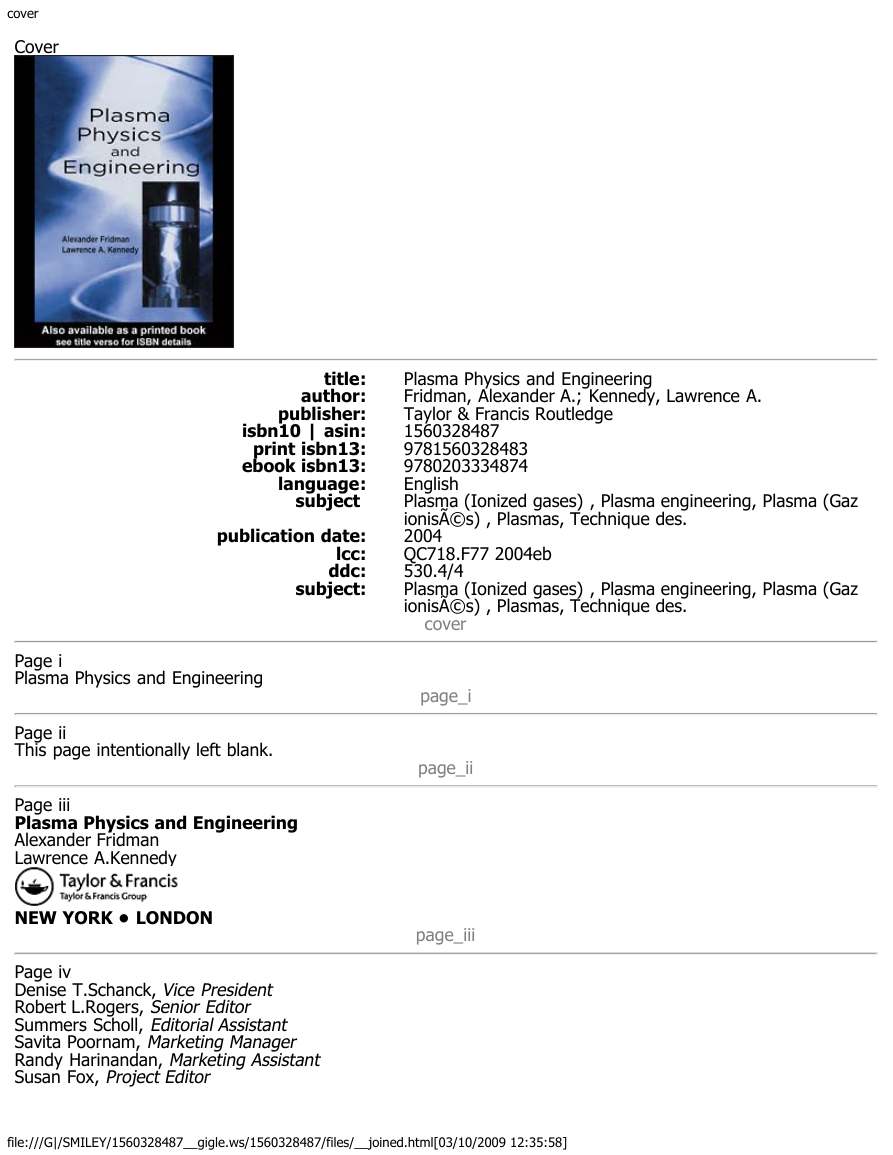
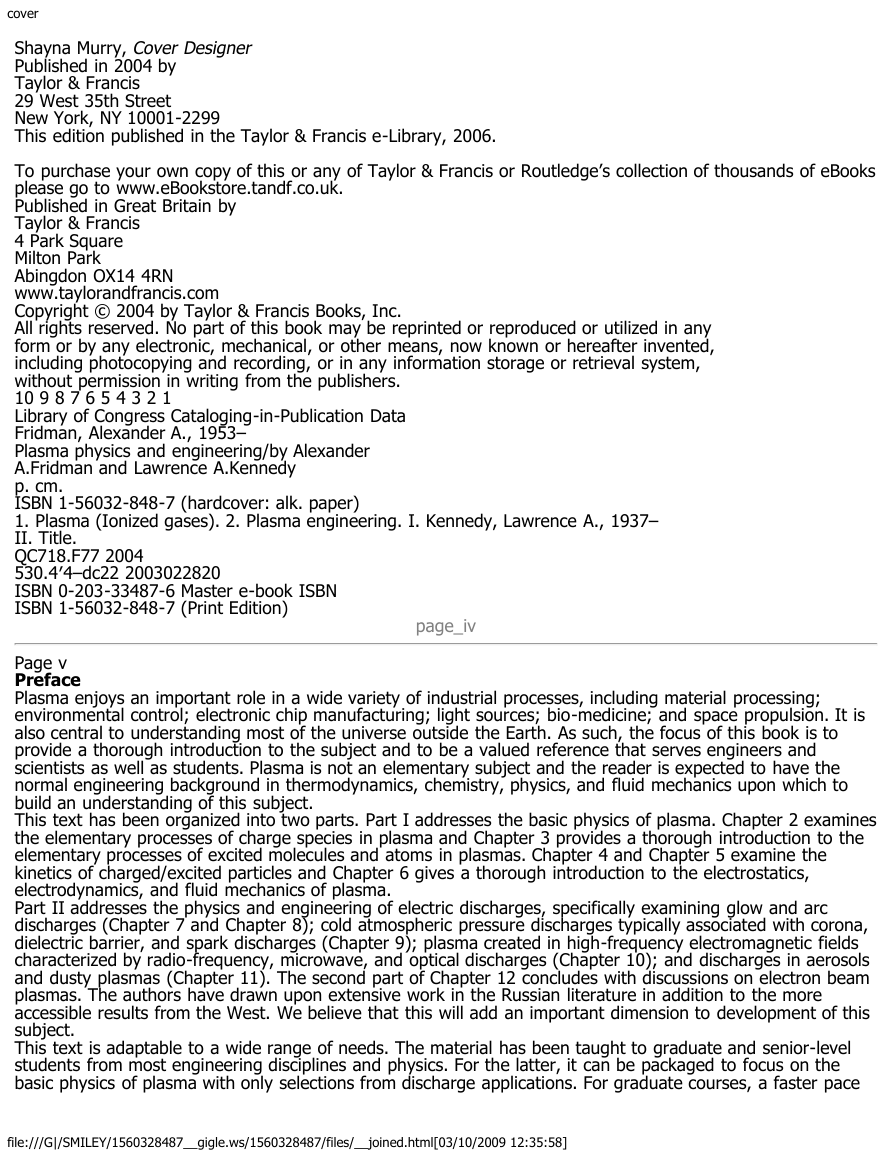

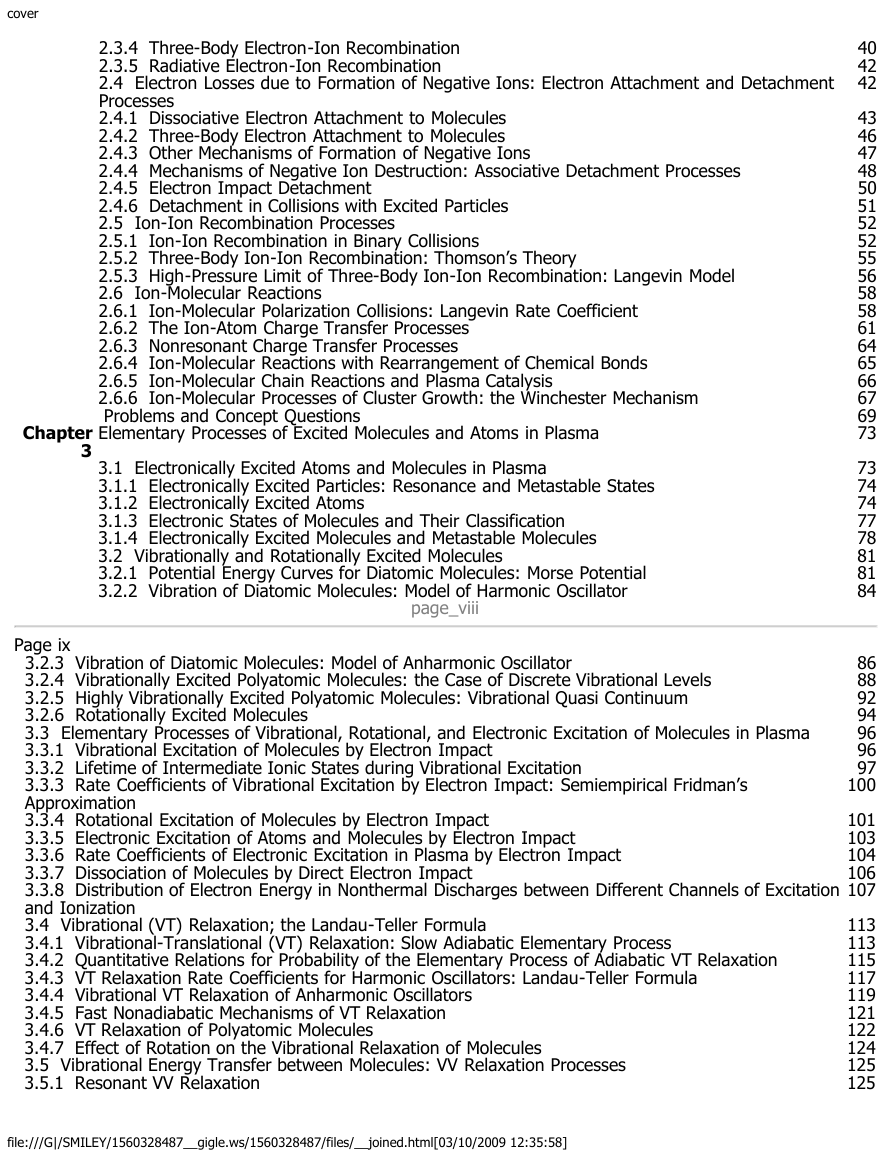
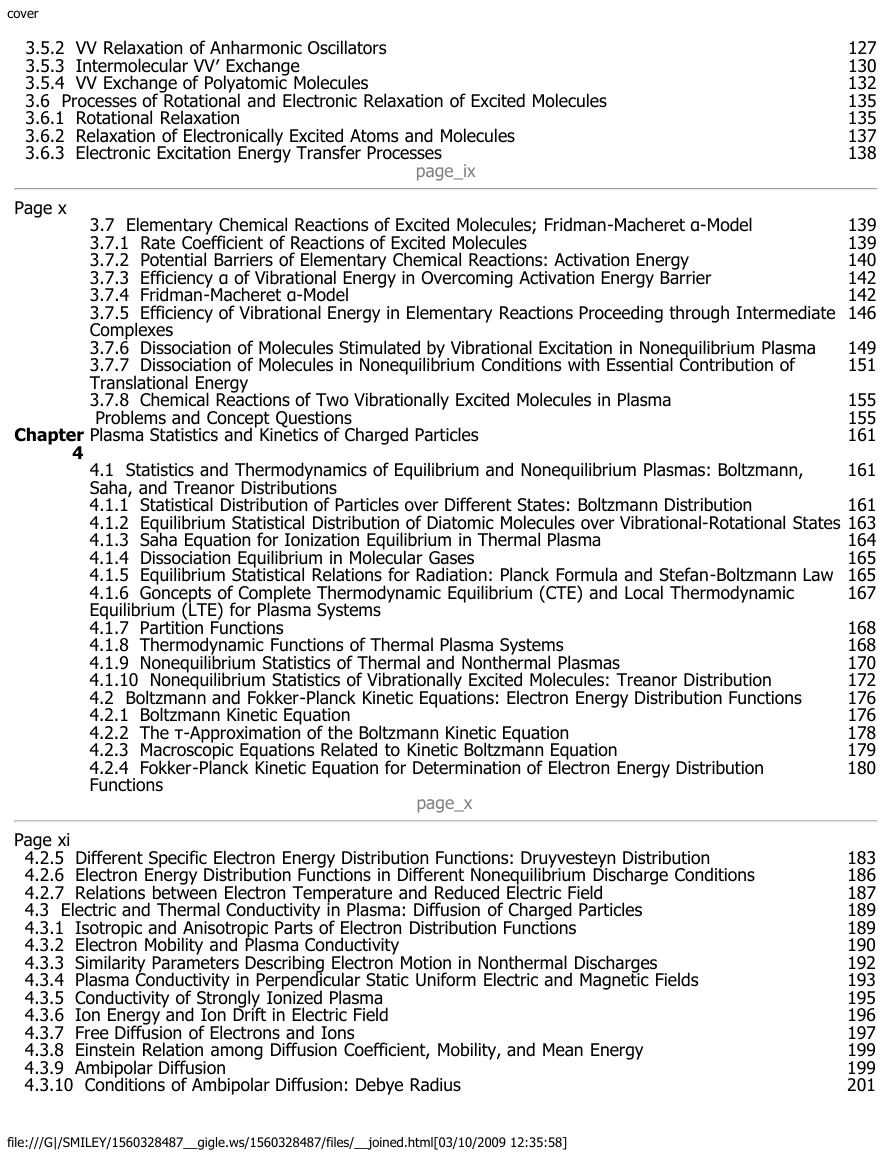

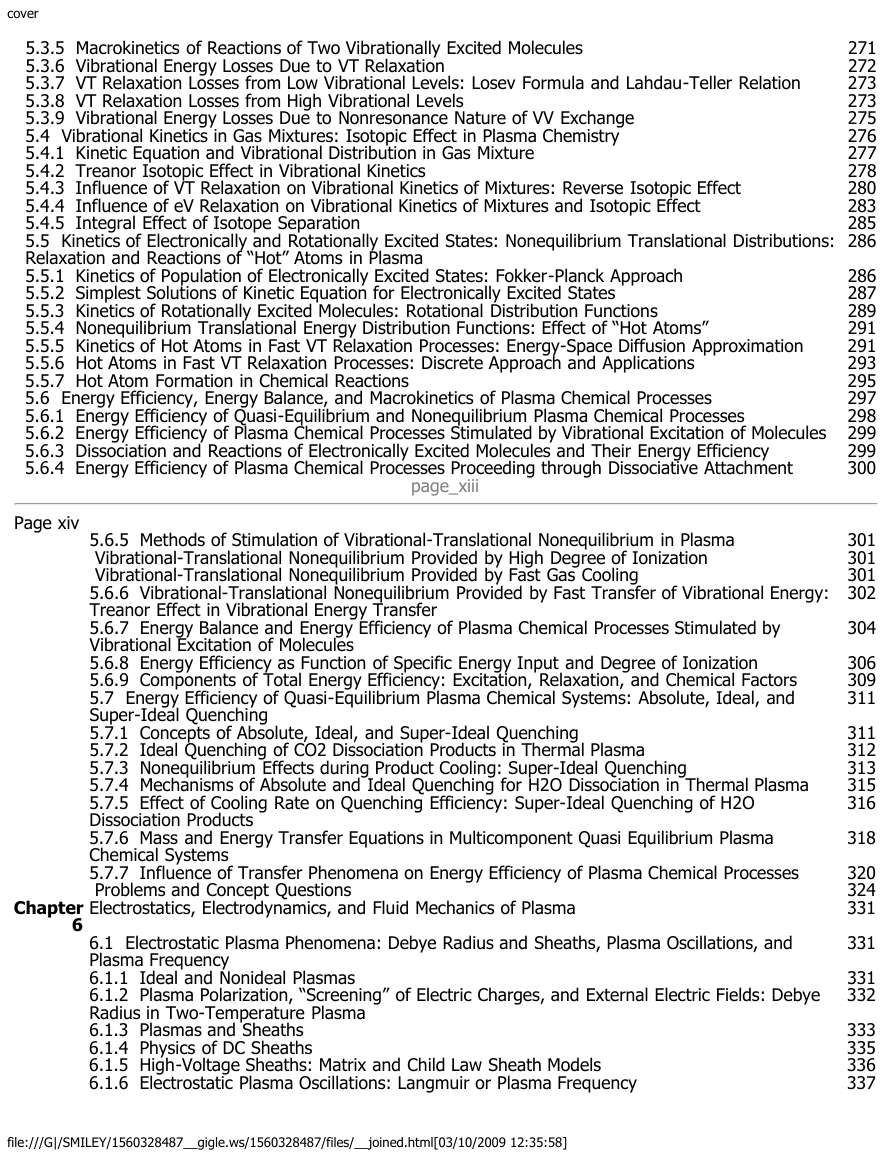









 2023年江西萍乡中考道德与法治真题及答案.doc
2023年江西萍乡中考道德与法治真题及答案.doc 2012年重庆南川中考生物真题及答案.doc
2012年重庆南川中考生物真题及答案.doc 2013年江西师范大学地理学综合及文艺理论基础考研真题.doc
2013年江西师范大学地理学综合及文艺理论基础考研真题.doc 2020年四川甘孜小升初语文真题及答案I卷.doc
2020年四川甘孜小升初语文真题及答案I卷.doc 2020年注册岩土工程师专业基础考试真题及答案.doc
2020年注册岩土工程师专业基础考试真题及答案.doc 2023-2024学年福建省厦门市九年级上学期数学月考试题及答案.doc
2023-2024学年福建省厦门市九年级上学期数学月考试题及答案.doc 2021-2022学年辽宁省沈阳市大东区九年级上学期语文期末试题及答案.doc
2021-2022学年辽宁省沈阳市大东区九年级上学期语文期末试题及答案.doc 2022-2023学年北京东城区初三第一学期物理期末试卷及答案.doc
2022-2023学年北京东城区初三第一学期物理期末试卷及答案.doc 2018上半年江西教师资格初中地理学科知识与教学能力真题及答案.doc
2018上半年江西教师资格初中地理学科知识与教学能力真题及答案.doc 2012年河北国家公务员申论考试真题及答案-省级.doc
2012年河北国家公务员申论考试真题及答案-省级.doc 2020-2021学年江苏省扬州市江都区邵樊片九年级上学期数学第一次质量检测试题及答案.doc
2020-2021学年江苏省扬州市江都区邵樊片九年级上学期数学第一次质量检测试题及答案.doc 2022下半年黑龙江教师资格证中学综合素质真题及答案.doc
2022下半年黑龙江教师资格证中学综合素质真题及答案.doc